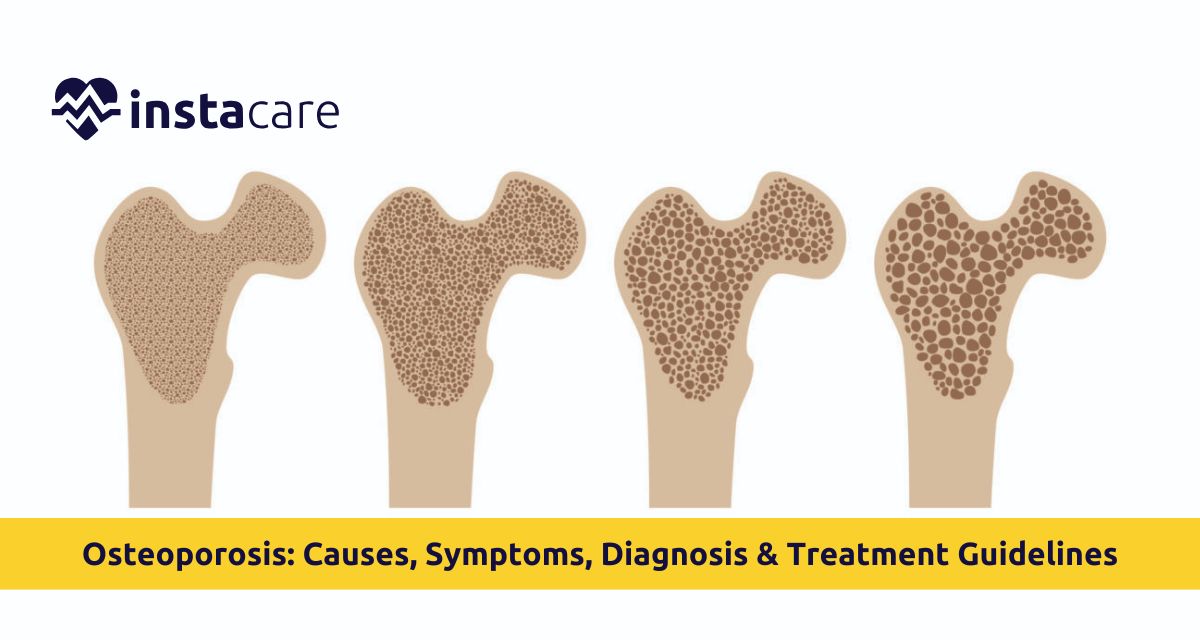Two words that constitute this name literally mean brittle bones, that is, bones made brittle, hard, and loose consequently minimising the risk of fracture because of the Bone density loss. Osteoporosis is called the "silent disease" as it keeps damaging bones without sharing any symptoms until something terrible happens-like a fracture. Osteoporosis affects millions of people all over the world, but has very high prevalence in postmenopausal females, and also affects men.
In this guide, we are going to discuss the causes of osteoporosis, typical symptoms of osteoporosis, diagnosis (DEXA scan/Bone Density Test), treatment options available, and finally some useful tips to prevent osteoporosis.
Understanding Osteoporosis and Its Impact
Osteoporosis means "porous bones." Healthy bones have small spaces; in osteoporosis, those spaces grow so large as to weaken the bone. Loss of bone density makes a fracture more likely, particularly in the hip, wrist, and spine.
Osteoporosis results in over 8.9 million fractures annually. Osteoporotic fracture in advanced age is a source of pain, disability, loss of function, and disease-attributable death.
Etiology of Osteoporosis
Pathogenesis of osteoporosis is multi-factorial and can be viewed as a interplay between disease, life style, hormonal change, and aging.
Hormonal Factors
Among very few of the causes really worthy of mention is hormonal imbalance, i.e., in women.
Osteoporosis during postmenopause occurs due to deficiency of estrogen post-menopause. Bone loss occurs due to a lack of sufficient levels of testosterone in men also.
Deficiency of Food
Bone needs calcium to maintain bones, and bones need vitamin D. Undernourishment with Vitamin D and bone health or calcium leads to bone loss and loss more than necessary.
Disease
Hypothyroidism, celiac disease, rheumatoid arthritis, and chronic kidney disease lead to bone metabolic disease and osteoporosis.
Side Effects of Drugs
Corticosteroids, cancer chemotherapy, and prolonged use of some anti-seizure Osteoporosis medications lead to loss of bones.
Lifestyle
Consuming alcohol, smoking cigarettes, being inactive, and dieting are risk factors for osteoporosis. Lifestyle is accountable for poor growth of bones and worsening with time.
Risk Factors for Osteoporosis
It also lists your own risk factors for osteoporosis, and prevention and earlier diagnosis are positive aspects of that.
- Age (Age > 50)
- Female sex (better still postmenopausal)
- Family history of osteoporotic fracture or osteoporosis in first-degree relatives
- Short stature or less than average weight
- Long-term cigarette smoking and heavy alcohol consumption over many years
- Vitamin D or calcium deficiency
- Poor exercise programme
- Long-term corticosteroid treatment
- History of endocrine disease
You need to consult your doctor if you fall under one or more of the following groups.
Osteoporosis Symptoms
It is on reality day of the fact that a fracture had taken place that most patients with osteoporosis learn that they have the disease. Osteoporosis symptoms include:
- Low-impact fractures
- Back pain or pain in the back because of secondary fractures of the spine
- Increased height
- Slouching or bending forward (kyphosis)
- Bone tenderness or pain
Osteoporotic presentations are not inevitable but not rare, especially in the context of established risk factors.
Osteopenia vs Osteoporosis: What is the Difference?
- Osteopenia vs osteoporosis are on the road, i.e., below normal bone mineral density but not osteoporosis.
- Osteopenia is a warning signal and must be treated or lifestyle intervened upon in such a manner that no further loss occurs.
- Osteoporosis is diffuse bone loss and apocalyptically increased risk of fracture.
- Detection of osteopenia will avoid or defer osteoporosis.
Osteoporosis Diagnosis: The DEXA Scan
Dexa scan (Bone Density Test) is the best test for osteoporosis. It's bone mineral density test without testing in certain areas of the body, the spine and hip.
- Low-dose X-rays are used to assess bone quality.
- Results are given in a T-score
- Greater than -1.0: Normal
- -1.0 to -2.5: Osteopenia
- Less than -2.5: Osteoporosis
Physicians also use fracture risk, history and physical, and laboratory testing as diagnosis.
Treatment of Osteoporosis
Treatment of Osteoporosis prevents bone loss, maintains current existing bone density, and minimizes risk of breakage. Treatment most commonly is medication, nutrition, and physical exercise.
Medications for Osteoporosis
- Bisphosphonates (Alendronate, Risedronate, Zoledronic acid): Prevents bone fracture.
- Denosumab: Monoclonal antibody prevents breaking down of bone.
- Teriparatide & Abaloparatide: Increases bone.
- Hormone Replacement Therapy (HRT): Initial use in postmenopausal osteoporosis.
- Selective Estrogen Receptor Modulators (SERMs): Maintains bones in women during menopause and postmenopause.
Calcium and Vitamin D Supplements
Ample calcium for bones and bones and vitamin D on the plate. Daily recommended dosage:
- Calcium: 1,000–1,200 mg
- Vitamin D: 800–1,000 IU
Lifestyle and Exercise
Exercise beneficial for building bone best osteoporosis treatment:
- Weight-bearing exercise: walking, running, dancing
- Resistance training: resistance band exercise or weight lifting
- Balance training: reduce the falls by practicing Tai Chi, Yoga
Quit smoking cigarettes, alcohol and exercise reduction are excellent therapy.
Osteoporosis in Women: Why the High Risk?
Women's hormones are responsible for osteoporosis in women. The bone matrix-forming hormone is estrogen, and once production ends after menopause, women lose tremendous bone mass.
Postmenopausal Osteoporosis
Osteoporosis of this category will also be vulnerable to cause:
- Spinal
- Hipopstatic
- Abnormal short stature
Preventive screening and early treatment will reduce disabling fracture risk.
Bone Strengthening and Prevention of Falls Exercises
Exercise positions bone, as well as muscle and balance, and prevents falls.
The following Exercises for bone strength are prescribed:
- 30 minutes per day brisk walking
- Resistance exercise or weight training of major muscle groups, twice a week
- Tai Chi or yoga to enhance flexibility and balance
If broken or bone-deficient, prior to beginning any exercise program, see your doctor or physical therapist.
Osteoporosis Prevention: Saving Your Bones
Osteoporosis prevention starts early if you have risk factors. The following are the steps through which you can reduce your risk:
- Dietary calcium and sufficient vitamin D
- Weight-bearing exercise on a regular basis
- Abrupt smoking cessation and decreased consumption of alcohol
- Annual bone mineral density checkup after the age of 50
- Earlier diagnosed disease follow-up specialty treatment
Conclusion
You can manage osteoporosis if only you succeed in finding it early enough so that things do not go awry. If you are able to discover the causes of osteoporosis, discover the symptoms of osteoporosis, take some preventive steps like having a DEXA scan, treating yourself, and making some changes in your lifestyle, then you are able to place yourself in such a way that you are able to prevent your bones from losing their density, and do not break up so much.
If bones are the problem, go see a health worker for prevention, diagnosis, and treatment only.
Please book an appointment with the
Best Rheumatologist in Lahore, Karachi, Islamabad, and all major cities of Pakistan through
InstaCare, or call our helpline at 03171777509 to find a verified doctor for your disease.

